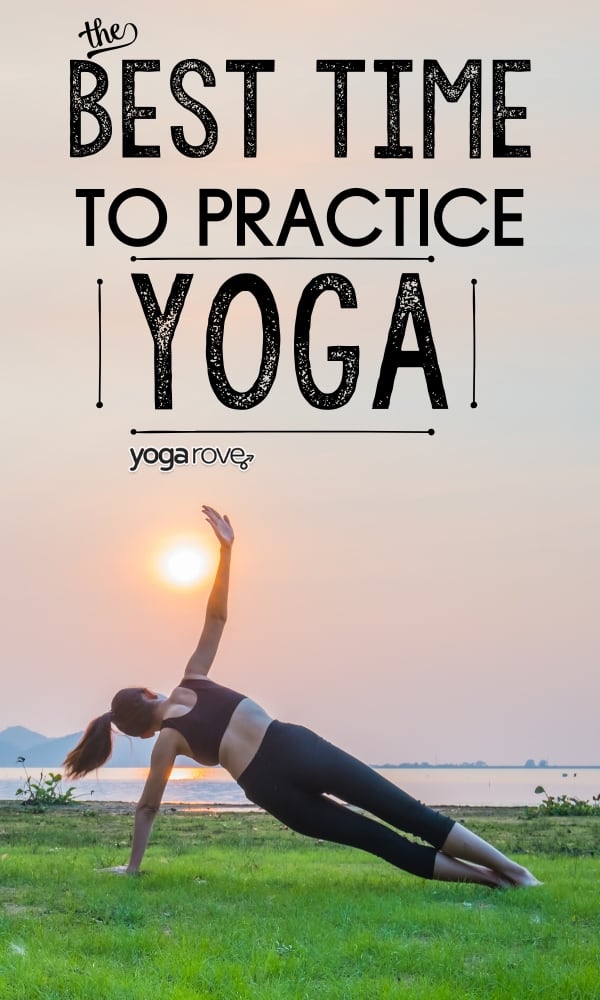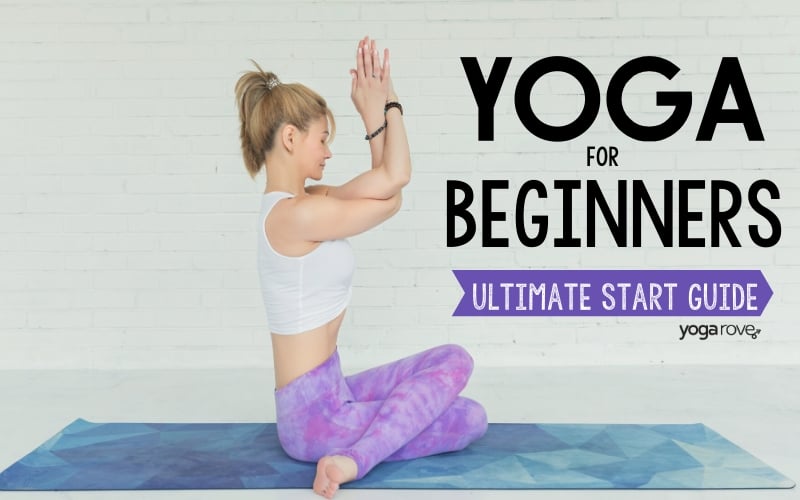This post may contain affiliate links. Please read our disclosure for more info.
My yoga practice schedule has varied wildly over the years: evening class immediately after a strength-training workout, a 4 AM – 1 PM “super practice”, late-night Yin, Hatha before breakfast, Vinyasa after breakfast… You name it, I’ve tried it.

When is the best time to practice yoga? The best time to practice yoga based on many traditional yoga teachers is in the early morning around 5 am, BUT in reality, you should pick a time that you know will allow you to consistently keep practicing and help you better reach your goals.
Note your energy levels, your reason for practicing, the factors that influence when your free time. Shape your practice around that.
This makes sure practice works for you so that you can gain the most benefit from it.
In addition to the reality of our lives, there is traditional wisdom surrounding yoga that can change when you choose to practice. The yogic masters shared teachings on time of day, seasons of the year, and even poses to do at different times of day.
Now, on to choosing a time to practice…
The best time to practice yoga is the time that will keep you coming back to your mat.
It’s that simple. Here’s why you should choose a time that keeps you coming back.
The benefits of a yoga practice unfold over time.
Yoga can help to develop strength, flexibility, and correct alignment within the body if practiced consistently.
It takes longer than a traditional workout or intensive stretching session because a beginner practice is usually gentler than the gym.
Yoga has enormous positive impact on our minds and mental health, too. It teaches us how to stay present with how we feel in our bodies.
A consistent practice encourages you to refine your awareness of your body and your feelings. If you only practice once every few weeks, it is challenging to maintain that type of awareness.
Consistency is key to gaining these benefits. Coming back to your mat at the same time and place over and over creates memory links that reinforce what you’ve already learned.
You’ll progress faster in your practice. You’ll start to see the benefits of yoga in your personal life, too.
Here are guidelines for choosing your practice time:
- Choose a time that keeps you consistent & committed
- Allow your goals, lifestyle, and body rhythms to shape practice times
- There is no one “best time”, but ancient yogis prefer early morning
- Different asanas work best for different times of day & different seasons
- It’s better to practice daily than to be a “weekend warrior”
We’ll go through each in the article.
Your goal for your practice influences its time of day.
Each practitioner has their unique goals for their yoga practice. Mine is to bring awareness to ‘sleeping’ body parts and to center my mind.
My self-practice takes place first thing in the morning before I answer a single text or Facebook message. My mind is clear because the stress of the day hasn’t begun.
I’ve put together a list of common goals expressed by my students with a recommendation for each.
- Exercise/Lose Weight: Choose a time of day in which you feel full of energy and attend a class at that time. Some folks find early in the morning easy for them (I don’t!), while others prefer lunchtime. Regardless, when you want to work up a sweat, practice at a time of day when you’re excited to get sweaty!
- Gain Flexibility: Afternoon or evening. Your body will be most flexible after being awake for a few hours. Going deeper into poses will be simpler later in the day. That said, think about lunchtime if you sit at a desk all afternoon, or consider walking to your yoga class instead of driving.
- Relax/rejuvenate: Night, after work & family obligations. A restorative practice provides the most benefits when our body is naturally relaxed. Our Circadian rhythms make the hours after sundown before bed a natural fit. You’ll want to select a time after your family duties are done, if you can, to ensure maximum relaxing.
- Deepen Spiritual Connection: Early morning or twilight hours of the evening. You’ll learn why in the “Yogic Masters” section below.
Time your practice with your body’s rhythms.
Yogis talk about the idea of svadhyaya, or self-study, underpinning a long-term yoga practice. This means that we allow ourselves to explore the effects of the practice in our body, mind, and day-to-day life.
Svadhyaya starts with understanding how our body responds at different times of day. For example, most people are stiff just after sleep, so diving into a sweaty hot yoga class might not be appropriate. Others might love it.
Track your energy levels throughout the day. Do you feel energetic after arriving at the office, only to fall into a slump just after lunch that lasts until evening? An active yoga practice right after work could be beneficial to return energy to your body.
On the other hand, if you are a serious gym go-er already, you may not have the power to propel into a tough active practice if you’ve already been to the gym. I once fell out of a headstand because I went to class after a rough shoulder & back day.
Evaluate how you feel at different points in the day to decide when to practice. Each person is unique!
Lifestyle influences the best practice time.
There are two lifestyle factors that influence practice time: family & home life.
This is huge for yogis with kids! Stay-at-home moms & dads, I’m looking at you! You guys often have the busiest schedules out of anyone and face daily domestic duties. Morning classes are your savior because you’ll have energy and less stress with the kids at school.
If you’re in your 20s or a student, you may find that later practice works better for you. It can be fun to join a hot yoga class later in the evening when you’re off work.
Seniors, daytime practice is beautiful to explore. Many studios offer daytime discounts for seniors so that they can join when other folks are at work.
No matter your age, for home practice, choose a time when you’ll be undisturbed by others. It can help to block time every day when your family/roommates know not to bother you.
And, make a commitment to yourself to ignore your phone! Your practice will benefit from undivided attention.
Don’t be afraid to step out of your comfort zone
Yoga is about understanding our boundaries so that we can work with ourselves. The time in which we practice exemplifies this idea.
It can be beneficial to explore different practice times to understand your body & mind. This shows us clearly where our work is so that we can grow.
I’ll provide an example from my personal life.
My boyfriend practices Ashtanga, a rigorous practice that pushes you to the limits of strength and flexibility.
He’s stiff in the morning. He practices in the evening. Ashtanga is traditionally an early morning practice – 4 or 5 AM!
Recently, he started exploring a morning practice. He was tired, of course.
What became difficult for him wasn’t his body or flexibility – it was his mind.
He had to conquer the idea that every Ashtanga practice had to push his limits. He had to conquer his perception of himself as a guy who kicked butt in every practice.
The work of yoga extends into every area of life.
Is it better to do yoga in the morning or at night?
A student asked me this question. Both times of the day are beneficial if you stick with it.
Typically, morning practices can be more energizing, while night practices relaxing.
That said, there are always exceptions. I’ve done restorative yoga in the morning after I woke up tired or sick.
It’s better to do yoga at a time of day that makes sense for you. Shoehorning a practice in when you’d rather be somewhere else is going to make it harder to stick with yoga long term.
As we know, the way to benefit from yoga is to stick with it.
Take the morning class. Take the evening class. Choose your favorite. Show up for yourself!
The yogic masters practiced in the twilight zone
While yogis these days (me included) espouse the idea of practicing at the best time for you, it’s interesting to note that the ancient yoga masters of India championed an early morning or twilight hour practice.
The same view persists today: the ashrams I lived on in India for some years typically began the practice around 4 or 5 AM.
From a logistic standpoint, an early morning practice makes sense. The world is quiet. The mind is quiet. It is easy to focus on asana and pranayama.
From an energetic standpoint, the energy of the world transitions at the times of sunrise and sunset. It becomes easier to tune into your own changes if the world is transforming around you.
For those who wish to dive in even deeper into yoga as a spiritual practice, the time of Brahma Muhurta is for you. This is the “witching hour” between 3:00 AM and sunrise when the pineal gland or “third eye” is said to be most active.
Sadhguru says that, “The Brahma Muhurta is the best time… if you want to transcend your physical nature or know the dimensions we refer to as spiritual.”
My last teacher told us that practicing during Brahma Muhurta was akin to “taking the elevator up to spiritual understanding while everyone else walks the stairs”. I’ve been happy with my stairs so far. Let me know if you choose the elevator.
How do I change my practice by time of day?
You’ll gain the most out of your practice if you adapt the style and poses you choose to the time of day. Certain poses stimulate the body & nervous system while others calm it down.
Let’s start with backbends, which are great in the morning & daytime. I know in my own practice that active and passive backbends can be better than a cup of coffee in the morning. They open the chest and shoulders after sleep, propelling you into the day.
Inversions are similar. Balancing your body on your hands in a handstand or on your arms in sirsasana (headstand) require effort! You’ll build up a sweat before you know it.
Further, inversions cause blood flow in the body to reverse with extra blood ending up in the head. This can cause us to have an active mind, making it hard to relax.
Sun salutations are also heating poses good for morning or daytime. They wake up all the muscles in the body and provide a cardio workout. You’ll get focused & fired up.
Twists and forward bends tend to have the opposite effect, making them ideal for later afternoon or evening. They release tight muscles by bringing extension into the spine and ground us mentally by causing us to focus inwardly.
You can combine different types of poses into a single practice to benefit your body based on the time of day. In the morning, start with seated forward bends or twists to wake up your muscles, then move into active poses. In the evening, try the reverse.
It’s also worth experimenting with a very active practice at night & in the morning to see how it impacts your body & sleep. That will provide you with the knowledge to build a practice for any time of day.
Does the practice change by seasons of the year?
The practice can and should adapt to the seasons of the year. Here are tips on customizing your practice.
Spring is a wonderful season to pay homage to the sun using Sun Salutations, or vinyasas. It becomes a dialogue between the two of you when you offer it Salutations each day.
If summer blazes hot, it is best not to push yourself too hard. Yoga poses naturally build physical heat. Plus, they build heat within the nervous system. Can you use the weather as a tool to move away from your edge?
According to Yoga International, cooling pranayama practices like Sitali and Sikari are excellent tools to ward off the heat of summer. They use the tongue as a “straw” so that you “drink” wet, cool air.
Summer is an excellent time to incorporate restorative poses like supported Viparita Karini (legs up the wall) and paschimottanasana with a bolster on the legs. These poses create coolness in the mind as the body rests on support.
Autumn presents a time for new beginnings and heart-opening. As the temperature drops, incorporate more vigorous, energizing poses like deeper backbends and inversions.
Winter is an excellent time to explore the most active poses. The weather is cool & your body needs the exercise!
Consider deep backbends like Danurasana (bow pose) and Ustrasana (camel pose). Arm balances like Astavakrasana (eight-angle pose) and Bakasana (crow pose) will boost your energy & add loads of fun!
How long should you practice?
Every day for the rest of your life! I had to say it. I’m a teacher.
The ideal duration of a daily practice depends on you.
Know that doing some practice is better than no practice or cramming it on the weekend. It’s more beneficial to hop on your mat for five minutes of breath work and five minutes of stretching than to ignore your mat that day or “save it until the weekend”.
Keep your goals in mind when deciding how long you want to practice. Are you trying to achieve physical, mental, or personal growth goals?
A yogi is more likely to be able to fit into her old skinny jeans if she practices for 30 minutes four times a week than if she practices for one hour twice a week. That’s biology.
Similarly, you’ll be more focused at home or at work if you take the time to sit in meditation each morning for a few minutes. Even five (really!) is better than trying to sit for 30 minutes once a week and suffering through it.
Consider personal growth goals, too. Was it your objective this year to throw yourself 100% into a new activity? How about using yoga as a way to connect with new friends? Creating a consistent habit to practice will help you get to where you want to be.
Finding your ideal time to practice
Ultimately, the ideal time to practice is the time in which you can practice.
Yoga is a “whole life” practice. We carry our lessons off the mat into the world, shaping relationships, jobs, and feelings.
We live consciously as a result of the practice.
We practice all the time, every day.
Related Questions
Is it okay to do yoga before bed?
Of course! Stick to a gentle or restorative practice to prepare the body for sleep.
How may days a week should you do yoga?
For athletes, consider starting with twice a week. For newbies, consider signing up for a beginner’s course at your local studio. They’ll recommend a proper amount of practice.






